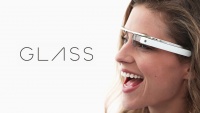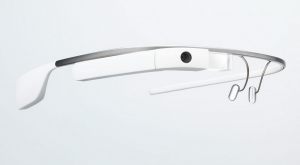Difference between revisions of "Google Glass"
| Line 25: | Line 25: | ||
=== Device === | === Device === | ||
| − | Google Glass itself is essentially a device containing all of the functions of a smart phone in the form of a headset worn similarly to eyeglasses. There is a small prism-like screen <ref name="ref1">The Washington Post: [https://www.washingtonpost.com/news/the-switch/wp/2014/02/27/everything-you-need-to-know-about-google-glass/]</ref> attached to the corner of one of the frames that serves as the display fitted with LED illumination. The beam splitter within the lens reflects the light given off at 45° into the user’s eye. The device comes equipped with a camera able to take photographs and 720p HD video as well as various other applications installed allowing access to social media, email, etc. All of this is controlled by a small touch pad found on the side of Google Glass that allows swiping through information on the screen and the use of natural language voice commands seen with [[Cortana]], for example. | + | Google Glass itself is essentially a device containing all of the functions of a smart phone in the form of a headset worn similarly to eyeglasses. There is a small prism-like screen <ref name="ref1">The Washington Post: [https://www.washingtonpost.com/news/the-switch/wp/2014/02/27/everything-you-need-to-know-about-google-glass/]</ref> attached to the corner of one of the frames that serves as the display fitted with LED illumination. The beam splitter within the lens reflects the light given off at 45° into the user’s eye. The device comes equipped with a camera able to take photographs and 720p HD video as well as various other applications installed allowing access to social media, email, etc. All of this is controlled by a small touch pad found on the side of Google Glass that allows swiping through information on the screen and the use of natural language voice commands seen with [[Cortana]], for example. <ref name="ref5">Wikipedia: [https://en.wikipedia.org/wiki/Google_Glass]</ref> |
==See Also== | ==See Also== | ||
Revision as of 21:40, 18 February 2016
|
Google Glass is a form of head-mounted technology worn in a similar fashion to regular eyewear. Developed by Google with the goal of Ubiquitous Computing in mind, Google Glass performs the functions of such hand-held technology as smart phones through optical displays and voice control. A prototype of the product was distributed to a group of people in the United States called “Glass Explorers” on April 15, 2013 for $1,500. It was available to be purchased by the public for the same price for a short amount of time starting in May of 2014. After growing concerns and criticism, Google pulled the prototype from production and distribution on January 15, 2015. However, the company continues to develop Google Glass in an effort to try to perfect the technology. [1]
Development
Google Glass was created by a subsection of Google called Google X. This is a research and development facility that has also worked on other largely innovative projects including the driverless car, an aerial delivery service similar to Amazon Prime Air, and even some currently rejected ideas such as a space elevator and teleportation. [2] Project Glass was announced in April 2012. It was not the first product of it’s kind as it has been preceded by other optical technologies in both the video game and military fields. [3]The current prototype is much smaller in scale and is now even lighter than a normal pair of glasses. For an extra fee of $225, Google provides multiple versions of prescription frames for users who require them. They have also worked with popular brands of eyewear such as Oakley and Ray Ban to design frames that differ from the original style. [1]
The original version of Google Glass was offered to be tested by a group of qualified individuals known as “Glass Explorers.” The first 2,000 of these were chosen from attendees at a June 2012 conference where Sergey Brin, the co-founder of Google, gave a demonstration of the product. Eventually this opportunity was made available to everyone. Google chose interested and creative people via Google+ or Twitter applications where individuals explained what they would do if they had access to Google Glass using the hashtag #ifihadglass. Glass Explorers received and began using their devices on April 16, 2014 – the day it went public. [4]
It was announced in January 2015 that the Glass Explorer program would be terminated and the devices would no longer be available to purchase in that way. In the mean time, Google is still working to improve the product as part of its own department within the company. [4]
Device
Google Glass itself is essentially a device containing all of the functions of a smart phone in the form of a headset worn similarly to eyeglasses. There is a small prism-like screen [5] attached to the corner of one of the frames that serves as the display fitted with LED illumination. The beam splitter within the lens reflects the light given off at 45° into the user’s eye. The device comes equipped with a camera able to take photographs and 720p HD video as well as various other applications installed allowing access to social media, email, etc. All of this is controlled by a small touch pad found on the side of Google Glass that allows swiping through information on the screen and the use of natural language voice commands seen with Cortana, for example. [1]

